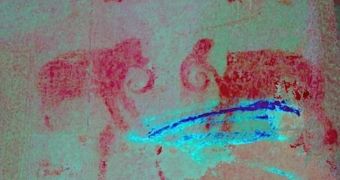A recent paper in the journal Antiquity details the discovery of about 200 hidden paintings at an ancient temple in Cambodia. One of these paintings, an image of which is available above, shows two elephants facing one another.
Live Science tells us that the temple on whose walls these hidden paintings have recently been discovered it is dubbed Angkor Wat. The religious monument was built back in the 12th century, and it now receives millions of visitors yearly.
However, none of these visitors has until now caught a glimpse of any of the 200 hidden paintings, and chances are that it will be a while until they do, provided that this might ever come to happen.
This is because the traces of paint that make up these images showing old deities, elephants, people riding horses, orchestral ensembles and even boats are so subtle that the paintings only become visible when color differences are exaggerated.
This method of unraveling hidden images by exaggerating color differences that are not noticeable to the naked eye of an observer is known to the scientific community as decorrelation stretch analysis, the same source tells us.
Despite the fact that this technique usually serves to explore so-called rock-art, i.e. human-made markings that adorn natural stone, it has also been employed by space researchers when trying to reach a better understanding of what the surface of Mars looks like.
Specialists who have had the chance to examine these images say that some of them are no more and no less than graffiti created by pilgrims who visited the ancient temple in its more recent history. Others are believed to be the work of people trying to restore the temple.
“A lot of the visible paintings on the walls have been previously discounted as graffiti, and I certainly agree with this interpretation,” says Noel Hidalgo Tan with the Australian National University in Canberra, who discovered the images.
“There are another set of paintings discovered from this study that are so schematic and elaborate that they are likely not random graffiti, but an attempt to decorate the walls of the temple,” the rock-art researcher goes on to explain.
The Angkor Wat temple in Cambodia covers an area of about 200 hectares (approximately 500 acres) and is believed to be one of the largest religious monuments to have until now been built. When it was first erected back in the 12th century, it was a Hindu temple honoring the god Vishnu. In the 15th century, however, it became a Buddhist temple.

 14 DAY TRIAL //
14 DAY TRIAL //